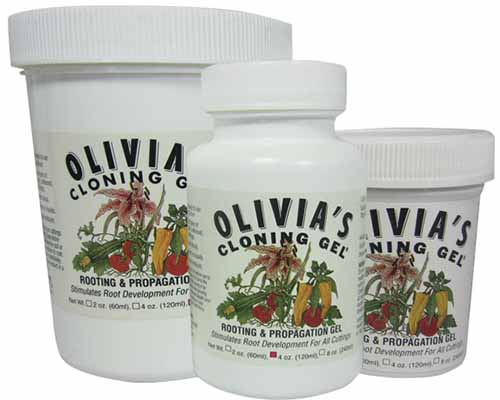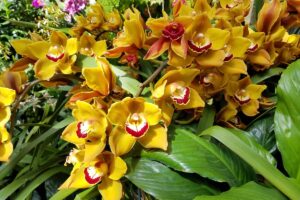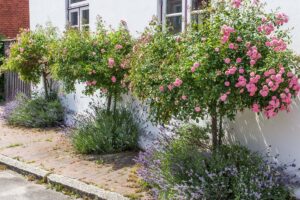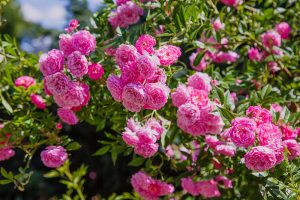Salvia dorrii
Purple sage is an arid climate native, and its silver foliage and purple blooms fill the air with a beguiling aroma.
This shrub attracts pollinators like bees and butterflies while providing gardeners with a waterwise option that stays tidy in the landscape.
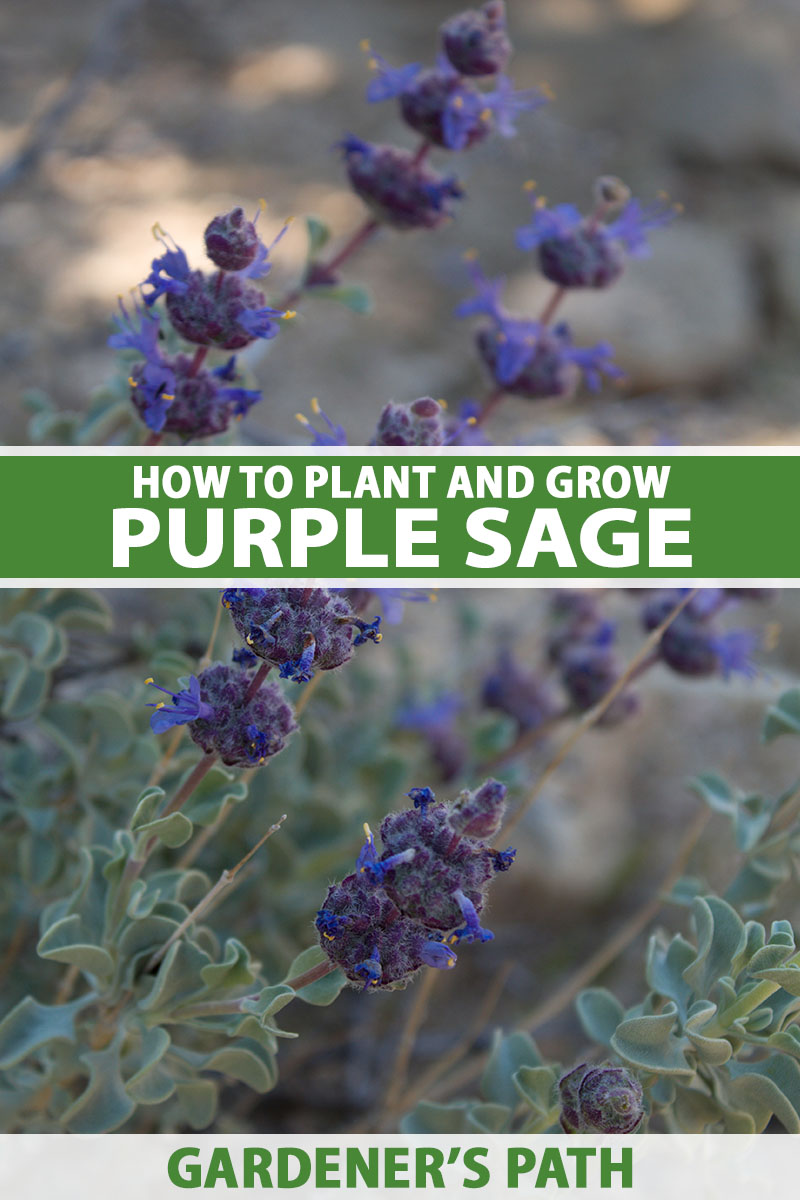
We link to vendors to help you find relevant products. If you buy from one of our links, we may earn a commission.
Gardeners who are dealing with watering restrictions and ongoing drought are wise to consider native species such as purple sage as substitutes for thirsty, exotic ornamentals.
Natives tend to be better adapted to local weather extremes and soil conditions, as well as having long-standing relationships with local fauna, making them less prone to disease and pest problems, and requiring less maintenance overall than many non-native species.
As a native species of the American West, purple sage is an excellent option for gardeners in this region who wish to cultivate a low-maintenance evergreen shrub.
We’re going to cover every step of growing this plant in the landscape – here’s a quick overview of what’s on the horizon:
What You’ll Learn
What Is Purple Sage?
Purple sage is an evergreen woody shrub or shrublet that is highly adapted to arid climates.
Classified botanically as Salvia dorrii, this species produces bicolored flowers in late spring to early summer.
Inflorescences are clustered at the end of stems, and bear fragrant blue flowers with purple bracts. Like the blooms of peas and orchids, these showy flowers are bilaterally symmetrical.

Blooms are held out from an upright, rounded, or spreading mound of foliage on branching and sometimes spiny stems.
Purple sage foliage is fragrant and ranges from greenish gray to blue to silver in color. This plant’s silvery foliage reflects the hottest light wavelengths, helping to keep the plant cool and reduce water loss.

This shrub has opposite leaves that are oval to lance shaped, and often folded inward.
It can survive low temperatures plummeting down to about -20°F, and can be grown in USDA Hardiness Zones 5 to 9.
S. dorrii shares the common name “purple sage” with another member of the Salvia genus, S. leucophylla.
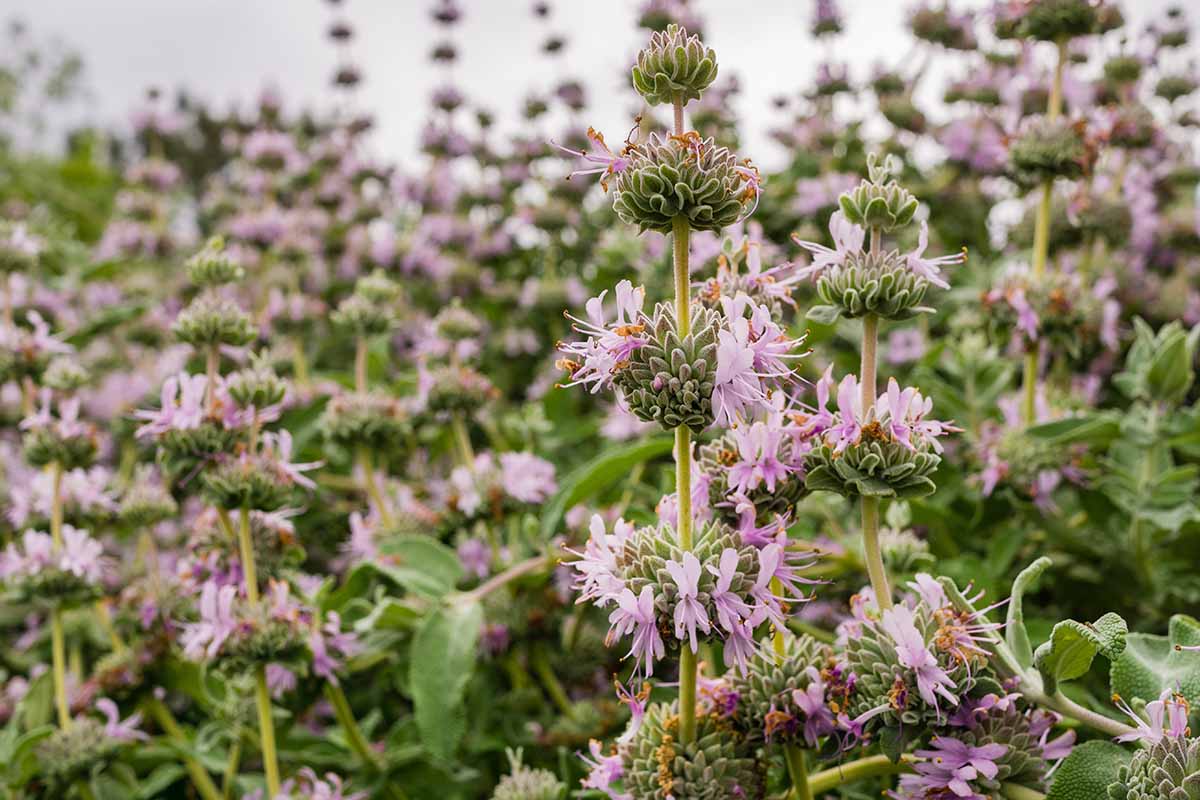
This other salvia’s native range is limited to coastal southern California.
S. leucophylla can grow much larger than the subject of this article, and while it’s also a waterwise option, it isn’t quite as well-adapted to extreme xeric conditions.
Cultivation and History
Purple sage is native to the western United States, including Arizona, California, Idaho, Nevada, Oregon, Utah, and Washington.
Found in the arid regions of this part of the country, this species with its royal hued blooms often grows among sagebrush populations in pinyon juniper forests, chaparral, scabland, or cool desert shrubland.
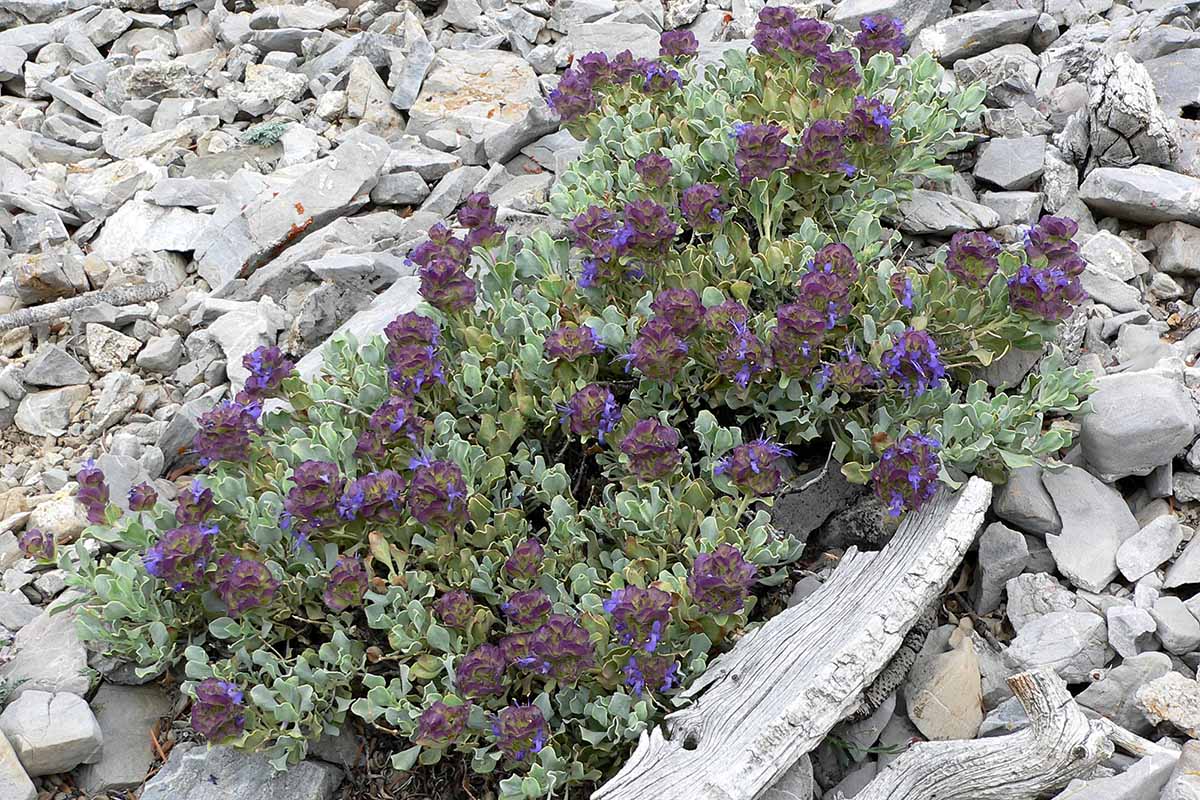
This member of the mint family, or Lamiaceae, is related to such culinary favorites as basil and mint. Within its genus, Salvia, it’s closely related to another herb, broadleaf sage, as well as the low water landscaping favorite, Russian sage.
Purple sage is sometimes called “desert sage,” “Dorr sage,” “gray ball sage,” or “tobacco sage.”
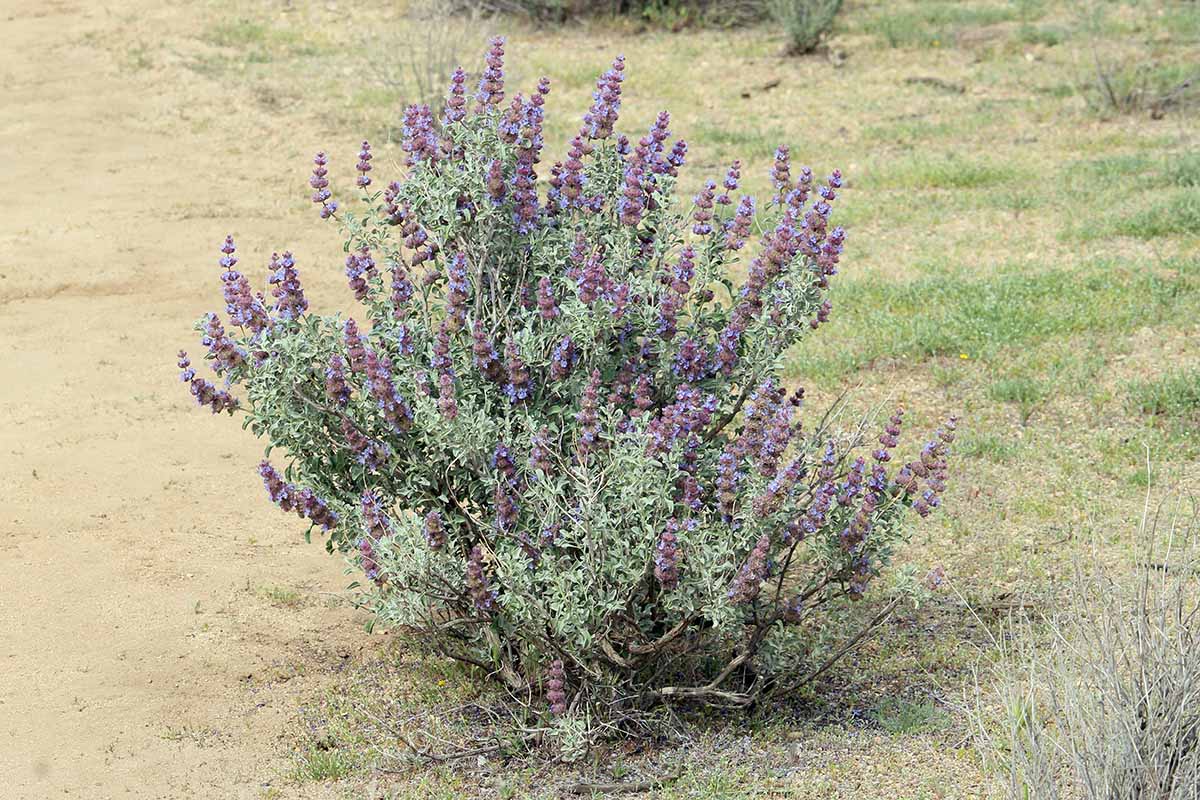
This arid climate species has a wide history of ethnobotanical uses.
Among its numerous medicinal uses, it has been used by the Northern Paiute as a cold remedy, the Shoshoni for treating upset stomachs, and by the Kawaiisu to alleviate headaches.
In addition to its reputation as a medicinal plant, S. dorrii achieved more widespread name recognition when it was prominently featured in a 1912 Western novel by Zane Grey, entitled, “Riders of the Purple Sage.”
Propagation
Desert sage can be propagated via seed or cuttings. We’ll discuss the process for both of these methods as well as covering how to transplant potted specimens.
From Seed
This type of salvia has better germination rates after a period of cold, moist stratification, so these seeds should be sown directly in the fall, or in the spring after chilling in the fridge.
For spring sowings, place desert sage seeds in moist sand and store in the refrigerator for six weeks prior to planting.
When you are ready to sow, prepare the planting area by removing any weeds.
Ultimately, these plants require two to three feet of space, so plant groups of seeds two to three feet apart, and a quarter to half an inch deep.
Plant several seeds for each plant you’d like to have, to make up for potentially poor germination rates. You can always thin seedlings later.
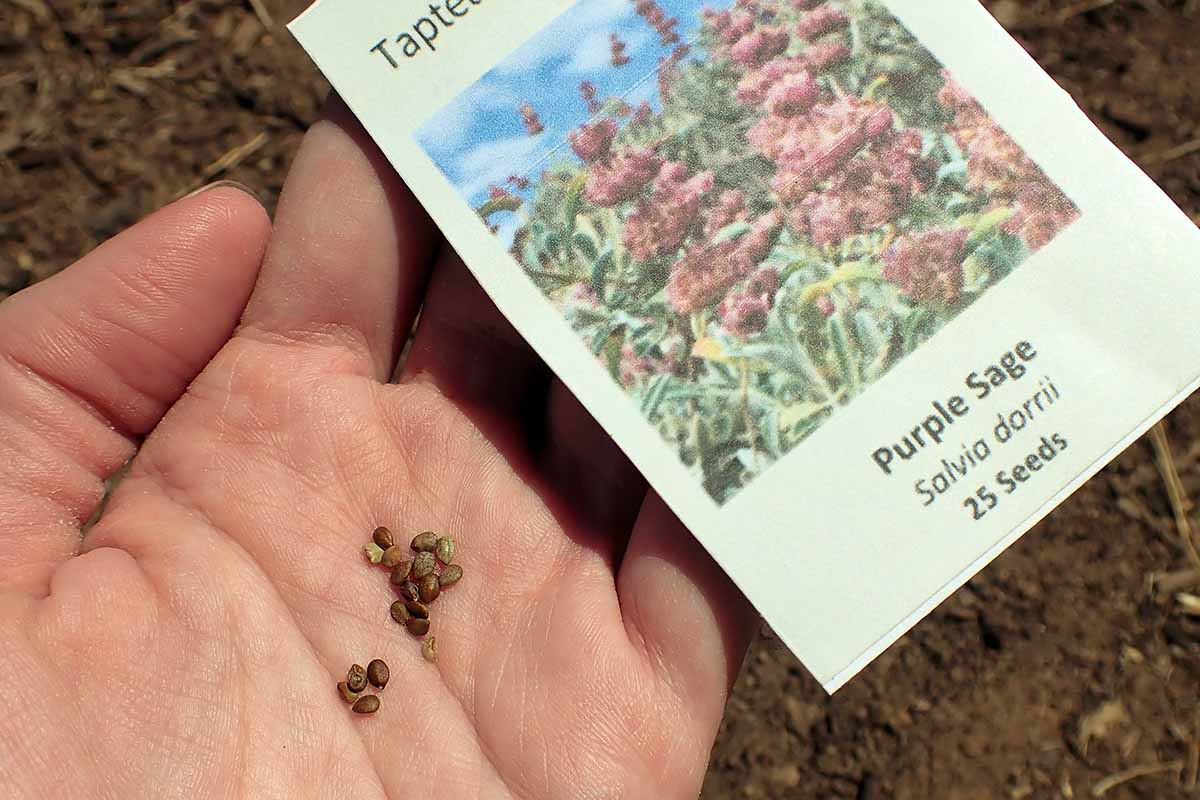
Water lightly, keeping the soil moist until they germinate.
If more seeds have germinated than you need, thin seedlings to one plant every two to three feet.
As young specimens get established, they will require more water than mature plants – water them every other day if there’s no rain. During hot weather, water daily.
Gradually taper off watering as young specimens become established.
From Cuttings
Experts at The Royal Horticultural Society recommend propagating this species of salvia via semi-ripe cuttings – that’s to say, cuttings in which the base of the stem is hard while the tip is still soft.
These cuttings should be taken in autumn.
Take a cutting that is four to six inches long, making sure to select a stem that looks healthy and is free from any signs of pests or diseases.
Leave at least four leaves attached at the tip of the cutting, and remove the rest from the bottom half closer to the cut end.
Dip the base of the cutting in cloning gel, then insert it into a four-inch nursery pot filled with growing medium.
You can purchase Olivia’s Cloning Gel in an assortment of sizes from Arbico Organics.
Be sure to choose a growing medium that has excellent drainage and is low in organic matter, such as those designed for cacti and succulents, like Sun Gro’s Black Gold cactus mix.
It’s available on Amazon in eight-quart bags.
Place the potted cutting in a greenhouse, or cover the pot with a plastic bag and locate it where it will be exposed to indirect sunlight throughout the day.
Water lightly, keeping the growing medium slightly moist until it has rooted – this may take a few months. Once the cutting has rooted, remove the plastic bag.
While established specimens are cold hardy, these rooted cuttings will need to acclimate before they are able to tolerate winter weather, so wait until all risk of frost has passed in spring to transplant them.
From Transplants
You may wish to use a garden journal to sketch out a design for your landscaping project before you get started. Whether you sketch out the details of your plantings ahead of time or not, allow two to three feet of space between plants.
Prepare to transplant your desert sage by digging a hole that is about double the width of its nursery pot and a few inches deeper.
If you are in a particularly arid region, you can help the transplant survive extreme climatic conditions by planting it in a small “crater.”
That means your plant will sit at a slightly lower level than the surrounding ground, in a depression that can catch and hold water as it runs off from the higher surrounding soil.
Once the hole is ready, remove the transplant from its pot, and loosen up the edges of its root ball with the palm of your hand.
Take some of the soil you removed from the hole, crumble it up, and place it back in the bottom of the hole. Next, situate the specimen in the hole.
If you are using the crater technique, the crown of the plant should be about an inch or so lower than ground level.
Now backfill with the soil you removed, but take care not to cover the crown of the plant with soil. The goal is to catch water around the plant, not to half bury it in soil.
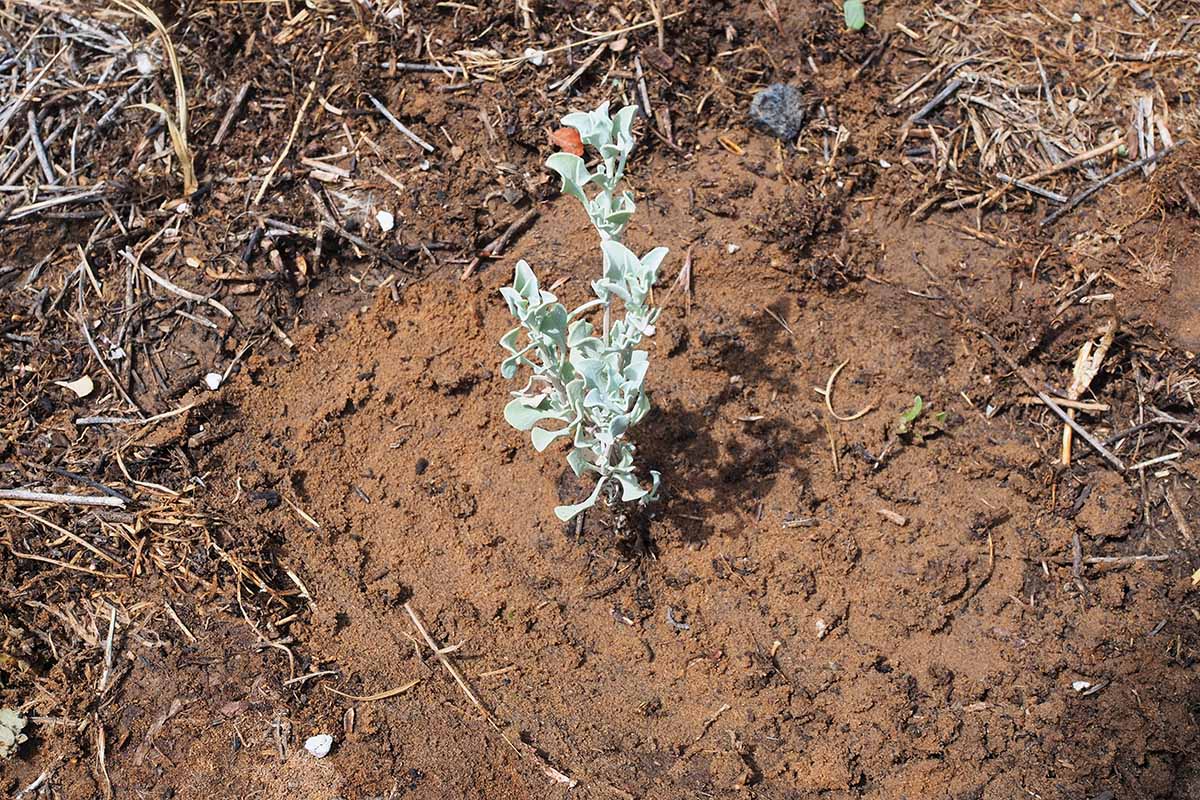
Water in the transplant. Until it becomes established, it will need water more frequently, so if the rain clouds aren’t doing the job for you, provide irrigation as needed.
For me, in my climate where I get roughly seven inches of water per year, I water newly transplanted specimens every day for about the first month, then gradually decrease from there.
How to Grow
Purple sage should be grown in areas where it can prosper in the arid conditions it is well-adapted to. If you live in a more humid area, I recommend choosing a type of salvia that is more adapted to your climate!
This species of salvia requires full sun and does best when grown in fast draining soils with a pH range between 6.0 and 7.8.
Grow this plant in soil types similar to what would be found in its native habitats – soils that are low in organic matter and include limestone, sand, and decomposed granite.
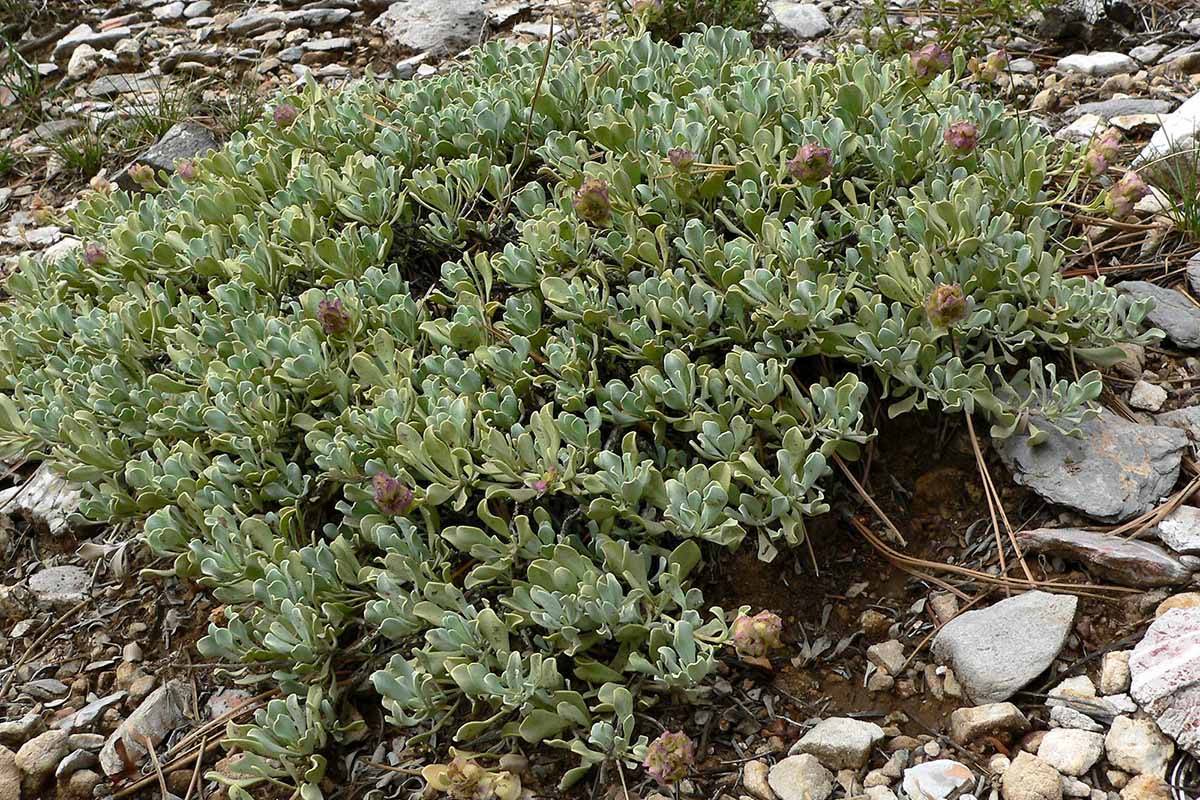
Desert sage is a xeric plant that can survive with as little as 3.7 inches of rain per year once established, but in some areas of its native range, this plant might receive as much as 35 inches of rain per year.
This species should require no irrigation once established.
Growing Tips
- Plant in full sun.
- Grow in rocky or sandy soil with fast drainage.
- Provide irrigation as needed until established.
Pruning and Maintenance
Like most other native plants, when grown in appropriate surroundings, desert sage will be a low maintenance selection for your garden.
S. dorrii will not require fertilizing since it’s well adapted to lean desert soils.
As for mulch, use only rock or gravel, since mulches such as leaf compost or pine bark contain too much organic matter, will raise ambient humidity, and may potentially cause fungal problems.
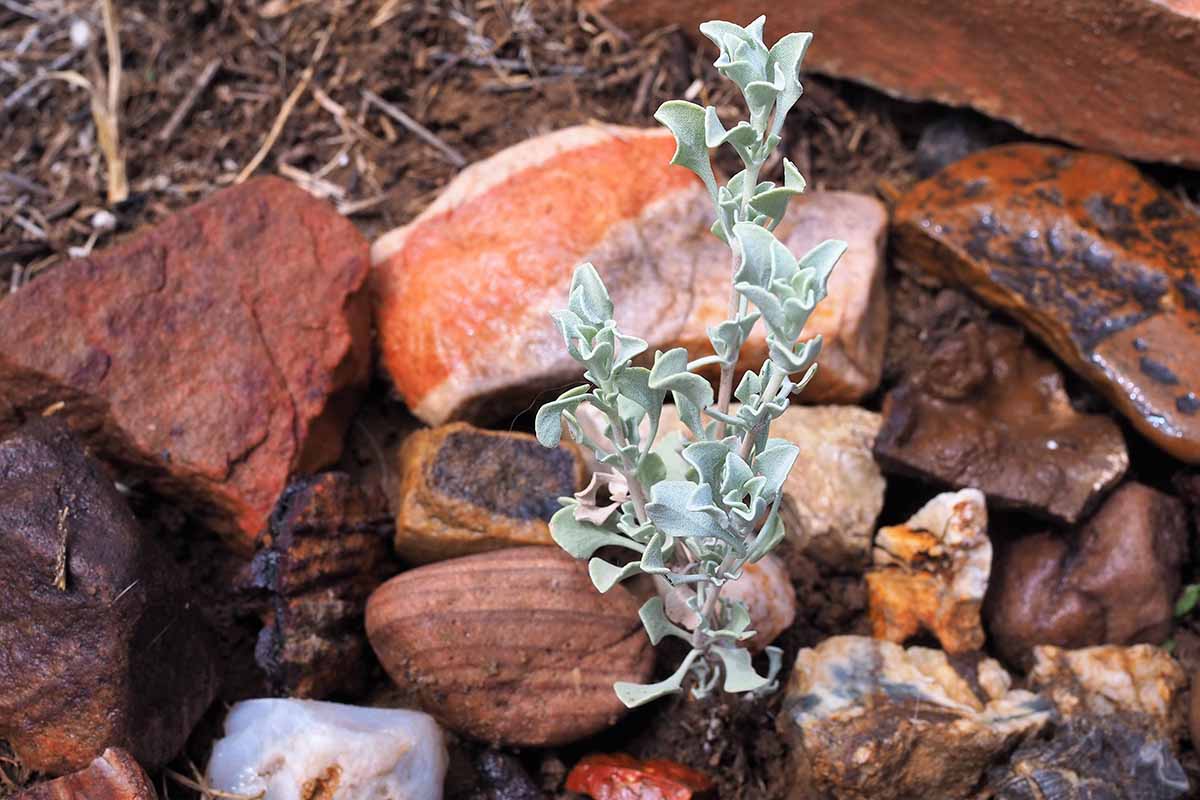
Mulching with rock or gravel will provide protection from both heat and cold, as well as slowing down encroaching weeds.
As for pruning, these flowers don’t need to be deadheaded, as their faded blooms can bring a certain beauty of their own.
Plus, the seeds of purple sage will provide a feast for various bird populations, including chickadees, grosbeaks, jays, and sparrows.
Specimens of S. dorrii often grow into a perfectly round mound that looks neat and tidy. However, if you end up with one that has other plans, you can use a pair of garden snips to shape it up a bit as needed.
Subspecies and Varieties
While there currently aren’t any cultivated varieties of this species available for sale, there are two subspecies of desert sage.
S. dorrii ssp. mearnsii is a subspecies that is sometimes called “Mearn sage” or “Verde Valley sage,” and it is found only in small populations in the wild in Arizona, where it is endemic and considered rare.
Its blooms are pink and purple.
As of 2001, according to Kristin Huisinga at the Ecological Restoration Institute at Northern Arizona University, Flagstaff, this variety was listed by the US Forest Service “as a sensitive species because of … limited distribution and threats to its survival.”
S. dorrii ssp. dorrii, the other subspecies, appears throughout the West, with blooms that are blue, purple, white, pink, or reddish. This subspecies has four known variants:
Clokeyi
With blue and purple blooms, S. dorrii ssp. dorrii var. clokeyi, sometimes described as S. dorrii var. clokeyi, is a low-growing plant with a mat-forming growth habit, found only in Nevada.
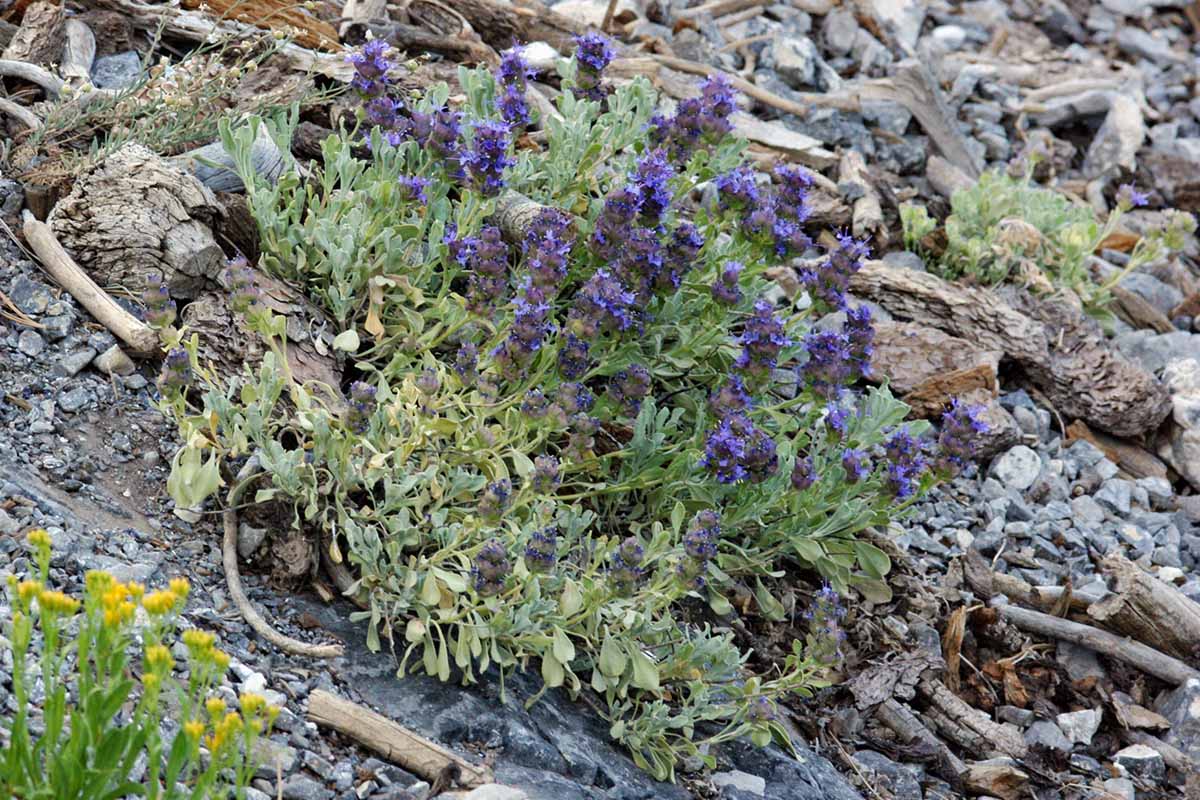
This variety, sometimes called “Clokey’s sage,” has a later bloom period, flowering from summer through early fall.
Dorrii
S. dorrii ssp. dorrii var. dorrii has blue and purple blooms, held on plants that can reach three feet tall and wide.
This variety is found in Arizona, California, Idaho, Nevada, Oregon, and Utah, and is sometimes called “Great Basin sage” – not to be confused with Great Basin sagebrush, a plant from the Asteraceae family.
Incana
S. dorrii ssp. dorrii var. incana – or, as it is also described, S. dorrii var. incana – has purple and blue blooms. Its native range includes parts of California, Idaho, Oregon, and Washington.

This variety has an upright growth habit with silver leaves, and is sometimes called “fleshy sage.”
Pilosa
S. dorrii ssp. dorrii var. pilosa (aka S. dorrii var. pilosa) is commonly called “hairy sage.”
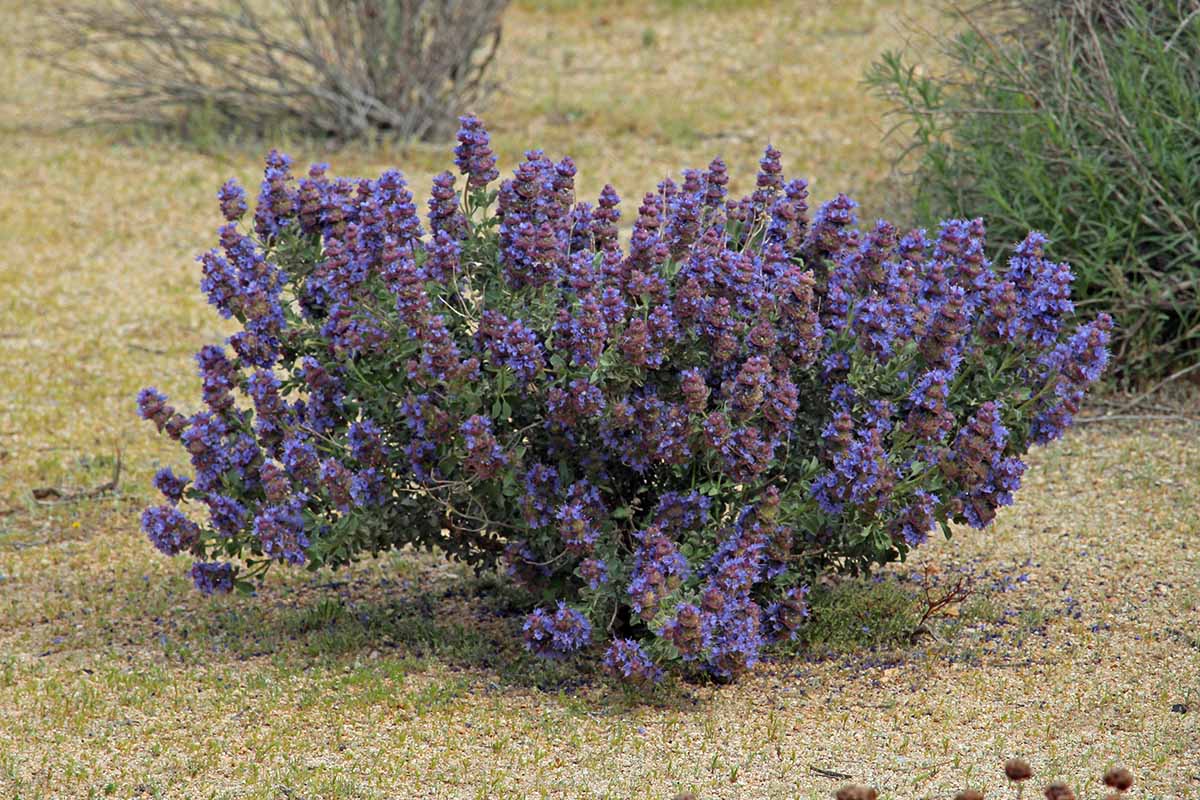
Native to Arizona, California, and Nevada, this variety reaches 20 inches in height and its blooms can be white, pink, blue, pink, purple, or white.
Where to Buy
Desert sage isn’t one of those shrubs like nandinas or boxwoods that you can easily find at your local big box store.
Instead, you will have the best luck finding seeds or transplants from local vendors.
Search for this salvia from nurseries specializing in Southwestern seeds and plant stock.
Sometimes schools or local botanical gardens hold annual or bi-annual plant sales, and these too may offer the native plants on your wishlist.
You might also try contacting your local native plant society to find recommendations for local sources of purple sage seeds, transplants, or cuttings.
For those harvesting plant material on public lands, be sure to check any regulations in your area, and be respectful of vulnerable populations, such as S. dorrii ssp. mearnsii.
Managing Pests and Disease
Purple sage is resistant to both deer and rabbits, though young specimens should be protected until fully established.
As for smaller herbivores, since this plant has evolved in its native ranges, it has developed defense mechanisms that allow it to resist most pests commonly encountered in those ranges.
Gardeners are most likely to encounter disease problems related to overwatering, which can allow fungal diseases such as crown rot or root rot to gain a foothold.
To prevent these diseases, grow purple sage in well-draining soil and water the surface of the soil rather than the top of the plant.
It’s also important to grow this species in well-adapted environments, avoid organic mulches such as bark or leaf litter, and go easy on the irrigation.
Best Uses
Purple sage has almost endless uses in the xeric landscape, where it can be incorporated into native plant landscaping or rock gardens.
It’s a pollinator favorite and can be used as a member of your insectary, providing forage for many types of pollinators.
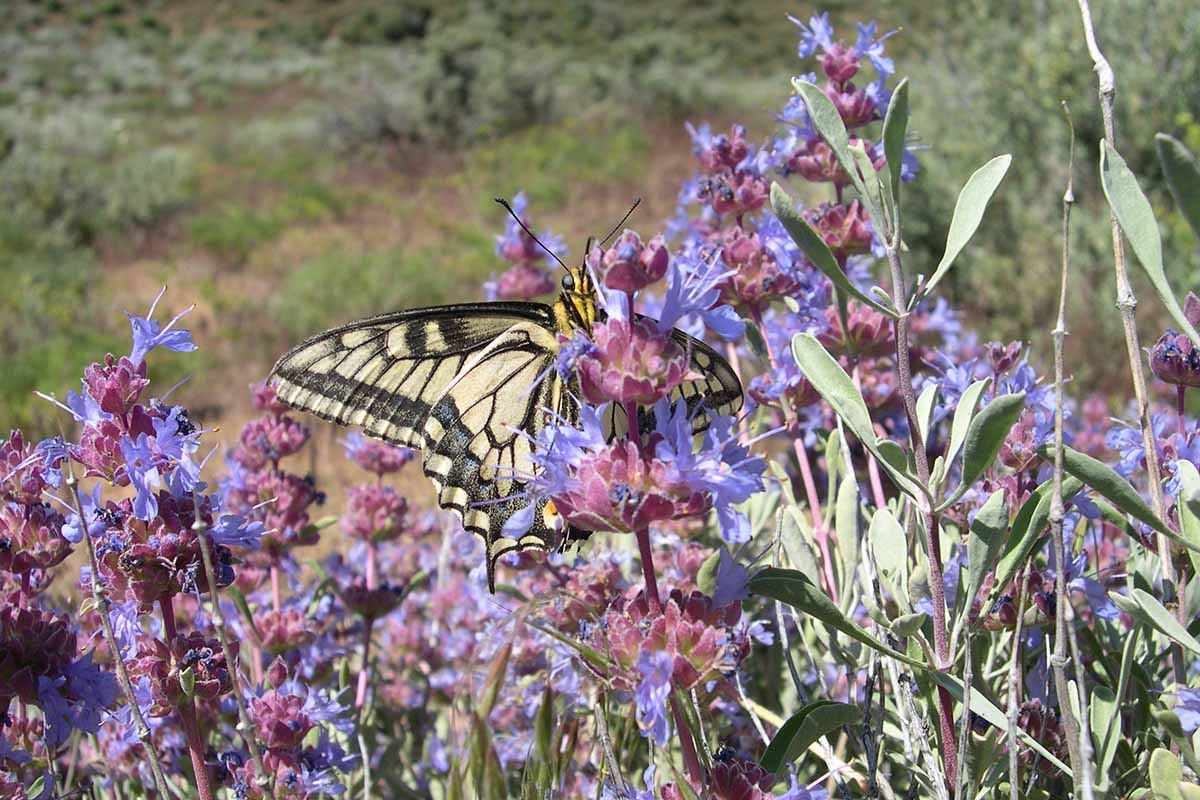
According to authors at the Lady Bird Johnson Wildflower Center, this species is of special value to native bees.
Purple sage is also loved by hummingbirds, and its seeds provide food for birds during the fall and winter.
For those wishing to create an oasis for local wildlife, purple sage is a host plant for several species of moths, including the wavy-lined emerald moth (Synchlora aerata).
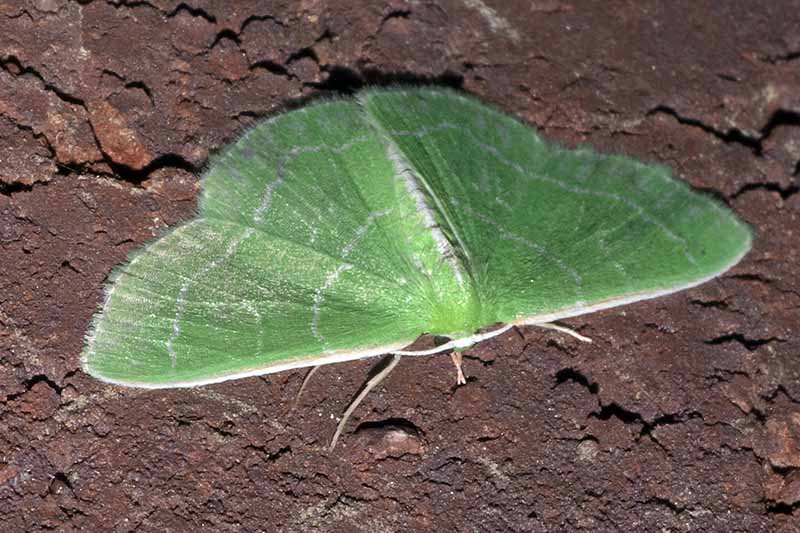
In the landscape it can be planted in large numbers to serve as a low hedge, or can be used individually as an accent plant. It can also be used to stabilize slopes.
Gardeners interested in stocking their gardens with medicinal plants may want to include desert sage in their plans.

And while the birds, butterflies, and bees will appreciate this native species, and its beauty will be readily apparent, another option is to include this pleasantly scented plant in an arid-climate aromatic garden.
Quick Reference Growing Guide
| Plant Type: | Evergreen woody shrub or shrublet | Flower / Foliage Color: | Purple and blue / silvery blue to grayish green |
| Native to: | Western United States | Tolerance: | Deer, drought, heat, poor soil, rabbits, slopes, wind |
| Hardiness (USDA Zone): | 5-9 | Maintenance | Low |
| Bloom Time: | Late spring, early summer | Soil Type: | Decomposed granite, limestone, sand |
| Exposure: | Full sun | Soil pH: | 6.0-7.8 |
| Spacing: | 36 inches | Soil Drainage: | Well-draining |
| Planting Depth: | 1/4- 1/2 inch (seeds), top of root ball even with soil line (transplants) | Attracts: | Bees, birds, butterflies, hummingbirds, moths |
| Height: | 12-36 inches | Companion Planting: | Buckwheat (Eriogonum spp.), Indian paintbrush, Joshua tree, juniper trees, penstemons, pinyon trees, sagebrush, winterfat, yuccas |
| Spread: | 24-36 inches | Uses: | Aromatic gardens, bee gardens, bird gardens, butterfly gardens, insectaries, low hedges, medicinal gardens, native landscaping, rock gardens, slopes, wildlife gardens, xeriscaping |
| Time to Maturity: | 1-2 years | Family: | Lamiaceae |
| Water Needs: | Very low | Genus: | Salvia |
| Growth Rate: | Moderate to fast | Species: | Dorrii |
| Common Pests and Diseases: | Crown rot, root rot | Subspecies: | Dorrii, Mearnsii |
A Darling of a Desert Dweller
I like to think of S. dorrii as simply adorable – low maintenance, a good team player, gorgeous to look at, and enchantingly aromatic.
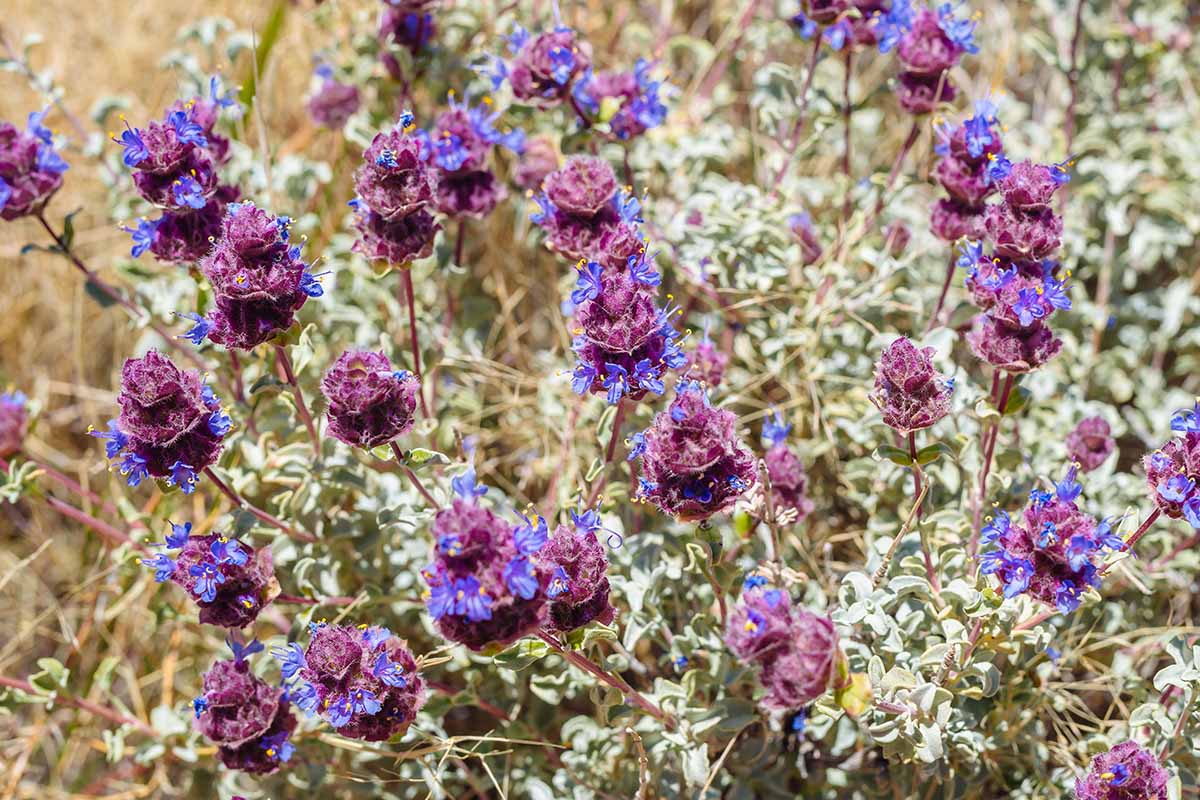
How are you planning to use this darling of a waterwise species in your landscape? If you have any questions or tips of your own, feel free to share them in the comments section below.
And you can keep adding to your knowledge of xeric landscaping options by reading these articles next:
